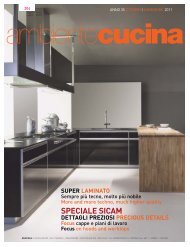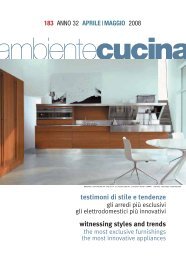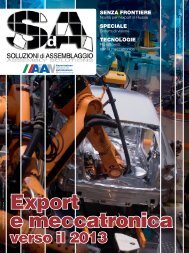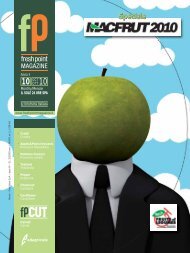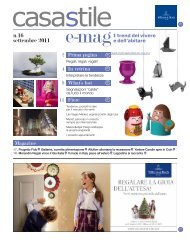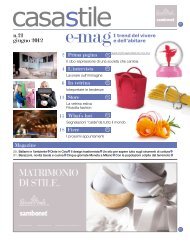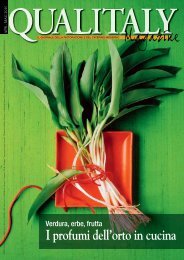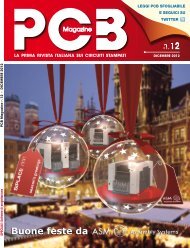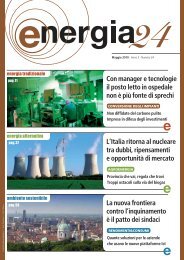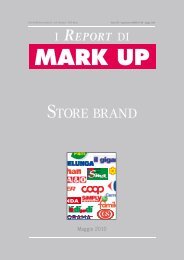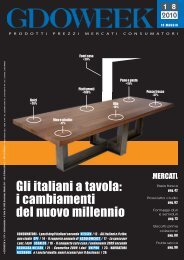Fresh Point Magazine - B2B24 - Il Sole 24 Ore
Fresh Point Magazine - B2B24 - Il Sole 24 Ore
Fresh Point Magazine - B2B24 - Il Sole 24 Ore
Create successful ePaper yourself
Turn your PDF publications into a flip-book with our unique Google optimized e-Paper software.
temperature control management – explains Jeff<br />
Brandenburg, Jsb Group Consultant, Llc Greenfield,<br />
Usa – can have a positive impact on the quality and<br />
shelf life of fresh-cut produce. It is important to understand<br />
that MAP is only effective if there is consistent<br />
temperature management throughout the entire life<br />
cycle of the product, including processing, as well as<br />
the entire distribution channel. Lack of temperature<br />
control will result in physiological variations that compromise<br />
the effectiveness of the packaging system».<br />
Brandenburg also adds: «Properly designed MAP is<br />
the combination of reduced O2 and increased CO2<br />
within the package, with the optimal combination<br />
being unique to each produce variety. By reducing O 2<br />
concentrations below about 10% around many fresh<br />
fruits and vegetables their respiration rate slows,<br />
which in turn indirectly slows the rates at which they<br />
ripen, age, and decay. In addition, reducing the O 2<br />
concentration can, in some cases, reduce oxidative<br />
browning reactions, which can be of particular concern<br />
in fresh-cut products. By increasing the CO 2<br />
level within the package, CO 2 dissolves in water and<br />
Brandenburg, consulente Jsb Group, Llc Greenfield, Usa<br />
– può avere un impatto positivo sulla qualità e la shelf-life<br />
dei prodotti di IV gamma. È importante comprendere che<br />
il confezionamento in atmosfera modificata è efficace soltanto<br />
qualora il controllo della temperatura sia costante<br />
durante l’intero ciclo di vita del prodotto, dunque anche<br />
durante la lavorazione e su tutta la catena di distribuzione.<br />
Se la temperatura non è sottoposta a continui controlli,<br />
infatti, si verificano variazioni fisiologiche che compromettono<br />
l’efficacia del sistema di confezionamento».<br />
Brandenburg aggiunge che «un’atmosfera protettiva<br />
adeguatamente formulata è la combinazione di ridotto<br />
contenuto di O 2 e concentrazione superiore di CO 2 nella<br />
confezione, una combinazione che varia da prodotto a<br />
prodotto. Riducendo la concentrazione di O 2 al di sotto<br />
del 10% circa, la frequenza respiratoria di molte varietà<br />
di frutta e ortaggi rallenta, causando il conseguente rallentamento<br />
di maturazione, invecchiamento e decomposizione.<br />
Inoltre, la diminuzione dell’O 2 può, in certi<br />
casi, ridurre l’inscurimento dovuto ai processi di ossidazione<br />
che possono costituire un problema per i prodotti<br />
freschi pronti per il consumo. Non solo aumentando il<br />
Where to find information on fresh-cut produce<br />
Dove trovare notizie sulla IV gamma<br />
Information by Adel Kader of the University<br />
of California, Davis (USA)<br />
Cook, R. 2011. Trends in the marketing<br />
fresh produce and fresh-cut products<br />
(Ppt presentation): http://ucce.ucdavis.edu/files/datastore/234-2115.pdf<br />
U.S. FDA. 2008. Guidance for Industry:<br />
Guide to Minimize Microbial Food Safety<br />
Hazards of <strong>Fresh</strong>-cut Fruits and Vegetables(http://www.fda.gov/Food/GuidanceComplianceRegulatoryInformation/Guidance-<br />
Documents/ProduceandPlanProducts/uc<br />
m064458.htm)<br />
<strong>Fresh</strong>-cut and Food Service Equipment<br />
& Supplies(http://postharvest.ucdavis.edu/yellowpages/?maincat=40)<br />
Information about optimal processing<br />
and handling procedures for fresh-cut<br />
products:<br />
University of California at Davis, Postharvest<br />
Technology Center’s<br />
“<strong>Fresh</strong>-cut Products: Maintaining Quality<br />
& Safety” workshop materials (http://post -<br />
harvest.ucdavis.edu/files/93535.pdf)<br />
University of Foggia (Italy), Research Unit<br />
on Postharvest Technology, 4 th European<br />
Short-course on “Quality & Safety of <strong>Fresh</strong>cut<br />
Produce” Course Material<br />
(http://www.agraria.unifg.it/en/Departments/PrIME/Course-Schedule/322/)<br />
Barth et al.2004. <strong>Fresh</strong>-cut vegetables<br />
chapter in USDA Handbook 66 (http:// -<br />
www.ba.ars.usda.gov/hb66/147freshcutvegetables.pdf)<br />
Beaulieu and Gorny.2004. <strong>Fresh</strong>-cut fruits<br />
chapter in USDA Handbook 66 (http:// -<br />
www.ba.ars.usda.gov/hb66/146freshcutfruits.pdf)<br />
Informazioni di Adel Kader dell’Università di<br />
California, Davis (Usa)<br />
Cook, R. 2011. Trends in the marketing<br />
fresh produce and fresh-cut products(presentazione<br />
Ppt): http://ucce.ucdavis.edu/files/datastore/234-2115.pdf<br />
U.S. FDA. 2008. Guidance for Industry: Guide<br />
to Minimize Microbial Food Safety Hazards<br />
of <strong>Fresh</strong>-cut Fruits and Vegetables<br />
(http://www.fda.gov/Food/GuidanceComplianceRegulatoryInformation/GuidanceDocuments/ProduceandPlanProducts/ucm064<br />
458.htm)<br />
<strong>Fresh</strong>-cut and Food Service Equipment &<br />
Supplies<br />
(http://postharvest.ucdavis.edu/yellowpages/?maincat=40)<br />
Information about optimal processing and<br />
handling procedures for fresh-cut products:<br />
University of California at Davis, Postharvest<br />
Technology Center’s<br />
“<strong>Fresh</strong>-cut Products: Maintaining Quality &<br />
Safety” workshop materials (http://postharvest.ucdavis.edu/files/93535.pdf)<br />
University of Foggia (Italy), Research Unit on<br />
Postharvest Technology, 4th European Shortcourse<br />
on “Quality & Safety of <strong>Fresh</strong>-cut Produce”<br />
Course Material<br />
(http://www.agraria.unifg.it/en/Departments/PrIME/Course-Schedule/322/)<br />
Barth et al.2004. <strong>Fresh</strong>-cut vegetables chapter<br />
in USDA Handbook 66 (http://www. -<br />
ba.ars.usda.gov/hb66/147freshcutvegetables.pdf)<br />
Beaulieu and Gorny.2004. <strong>Fresh</strong>-cut fruits<br />
chapter in USDA Handbook 66 (http:// -<br />
www.ba.ars.usda.gov/hb66/146freshcutfruits.pdf)<br />
<strong>Fresh</strong> <strong>Point</strong> <strong>Magazine</strong> n.3 – march/marzo 2012<br />
61



